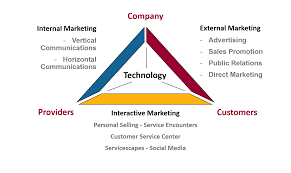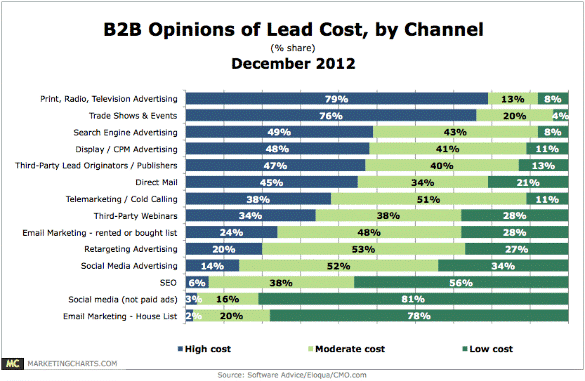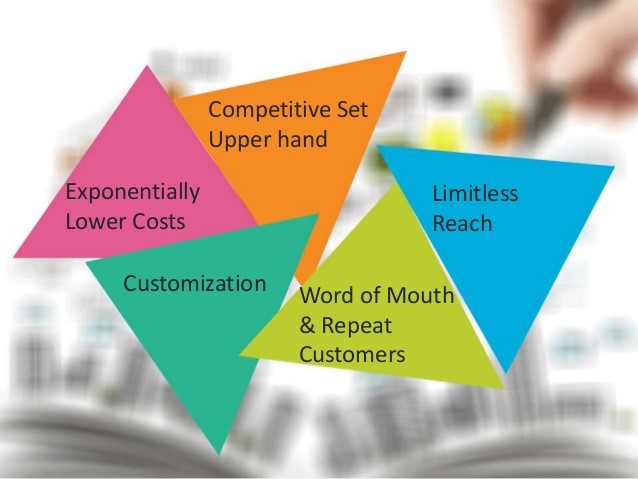Service Marketing Approach in Hospitality
- Service marketing is the No.1 strategy in the hospitality industry.
- They offer intangible services to satisfy customers or guests.
- Service marketing is mainly divided into three parts and maintaining balance. (Feature (1))

- According to the Management Study Guide (2016), services marketing first appeared in the 1980s when the debate started on whether the marketing of services was significantly different from that of products classified as a separate discipline.
- The American Association varies services as benefits, activities, or satisfactions provided for sale or offered with the sale of goods.
- Rafael Muñiz claimed (2016) that there are seven service marketing features, intangibility, inseparability, heterogeneity, perishability, changing demand, pricing of services, direct channel. (Feature 1)
Traditional Marketing Approaches
- Traditional marketing relies on offline strategies.
- Traditional marketing strategy includes direct sales, direct Mail, tradeshows, print advertising, referral, etc.
- The goal of traditional marketing is to create brand awareness.
- Although traditional marketing opinions vary, many marketers, especially in the B2B (business to business) space, do notbelieve that traditional marketing is effective. For example, in a recent survey, just 4% of respondents rated leads generated from print, radio, and TV ads as high quality.

How Is It Different from Service Marketing?
- Service marketing focuses on “customers” or “guests, while traditional marketing focuses on relative predominance.
- Traditional marketing considers customers as a buying person; however, due to an overflowing number of brands, products and information, new service marketing focuses more on relationships.
Benefits of Service Marketing

- Exponentially Lower Costs
- Customization
- Word of Mouth & Customers
- Limitless Reach
- Competitive Set Upper Hand
- Low-cost, high-impact channels for local marketing efforts include social media, local websites, and community event sponsorship.
- Users can adopt a service to their preferences, exercise control over their own experience, and increase their happiness and engagement.
- Word-of-mouth marketing is one of the powerful methods to advertise as 92% of consumers trust their friends over traditional media.
- Through service marketing, firms and organizations can reach their goal and create other perspectives to see the international situation.
- By following and adapting to contemporary trends, companies can get the upper hand among the companies operating hospitality or tourism organizations.
Aspects of Service Marketing
- Product – Your product requires a process performed by service providers. It is intangible. It does not exist unless you do something. This means your marketing must emphasize your performance and explain why it is superior in quality, price, or both to the competition’s offerings.
- Price – Service prices can seem arbitrary to the consumer. So emphasize your service’s value for the price. Most price objections occur due to underestimating the importance of service. So fill your marketing messages with references to your service’s value.
- Delivery – Your marketing should make it clear how the customer receives your service. If the customer must come to you, indicate that in your marketing.
- Branding – Many services are similar, so make your company memorable. Your marketing efforts must focus on branding your company as a quality provider with reliable services.
- Service Providers – Your service depends on the quality of your employees. The people providing your service can mean the difference between customer satisfaction and customer complaints. Your marketing should emphasize the quality of the people who provide your service.
- Time Frame – Emphasize the way you deliver your service. For example, if you provide your service overnight or within two weeks or 30 days, say so in your marketing message.
- Physical Differences – Because a service is intangible, you must find physical differences in your company’s aspects. If your service personnel are neat in appearance, say so. If your equipment is cutting edge, emphasize it. If customers are coming to your offices, emphasize your offices’ professional appearance as you create your marketing message.
- Quality – The quality of your service could be your most vital selling point. Your marketing must emphasize quality not only in the delivery of your service but in your follow-up and willingness to resolve customer problems.
Bibliography
- Social Marketing. 2020. Services Marketing. [online] Available at: <link> [Accessed 13 October 2020].
- Zeithaml, V., Bitner, M., and Gremler, D., 2010. Services Marketing Strategy. Wiley International Encyclopedia of Marketing,
- Social Marketing. 2020. Services Marketing. [online] Available at: <link> [Accessed 13 October 2020].
- Marketing, S., Kimbarovsky, R., and Kimbarovsky, R., 2020. Small Business Marketing Guide: Types Of Traditional And Online Marketing – Crowd spring Blog. [online] crowd spring Blog. Available at: <link> [Accessed 13 October 2020].
- 브란 코스 (BRANCOS). 2020. 콘텐츠 마케팅과 전통적 마케팅의 차이 10가지. [online] Available at: <link> [Accessed 13 October 2020].
- Taylor, 2020. Product Vs. Service Marketing: Benefits And Challenges. [online] Slideshare.net. Available at: <link> [Accessed 13 October 2020].
- Bluleadz.com. 2020. 5 Benefits Of Using Customization To Give Customers What They Want. [online] Available at: <link> [Accessed 13 October 2020].
- Investopedia. 2020. What Is Word-Of-Mouth Marketing?. [online] Available at: <link> [Accessed 13 October 2020].
- Yourbusiness.azcentral.com. 2020. [online] Available at: <link> [Accessed 13 October 2020].
